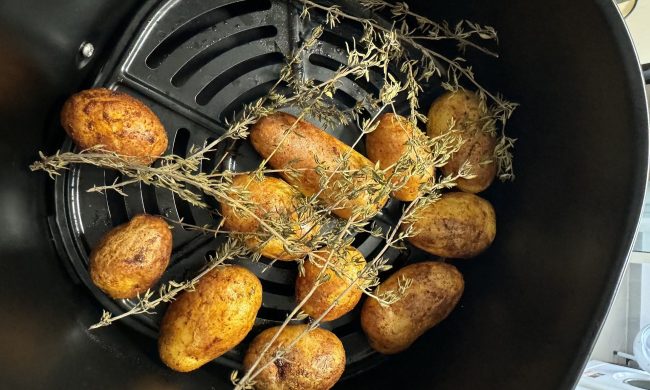For many aspiring chefs, dicing an onion is a tricky feat to accomplish. While the work is made harder by the tears that sting our eyes, it’s certainly no easy task to dice an onion in uniform cubes. Often, the diced onion ends up in varying sizes and leaves behind a mess for clean-up.
Tik Tok user, @lyndseymjames, has come up with an onion cutting technique that she believes makes dicing an onion easy and effective! While we admire Lyndsey’s creativity and passion in the kitchen, we had to ask ourselves if her technique was truly the best.

The Tik Tok that started it all
Not too long ago, Tik Toker, @lyndseymjames, posted a video of herself dicing an onion. The video quickly gained popularity and posed a vital culinary question. Is this the best way to dice an onion?
In her video, Lyndsey demonstrates her strategy of cutting an onion using the following steps.
First, she cuts off the end of the onion, also known as the shoot or stalk, leaving behind the roots or “hairy bits.”
She places the now flat portion of the onion on the table and grips the “hairy bits” to hold the onion in place.
Next, she begins making vertical slices from the top where she is gripping, down towards the table, following the natural grain of the onion.
Lastly, she flips the onion on its side and begins cutting the onion to form diced cubes.
@lyndseymjamesDiced onion hack! #hack #fyp
Why it works
Lyndsey’s technique is very similar to that of professional chefs. The difference between Lyndsey’s technique versus the technique of a professional is that she leaves out one step.
In Lyndsey’s technique, she creates a “flower” shape with the onion when she makes the initial vertical cuts. Her technique allows her to dice the onion without any problem and reduces the number of steps needed when following other methods.
Why it doesn’t
However, Lyndsey’s method has its drawbacks. One factor we can’t ignore is that her technique might be a bit more dangerous. When she turns the onion on its side to make the horizontal cuts that will result in diced bits, she rests the onion on the rounded side. The round side results in less control over the onion, and a small slip could lead to injury.
Additionally, her method of dicing an onion will result in differently shaped diced cubes. Parts of the onion closer to the root will be cut smaller than those closer to the flat portion she created. If uniform onion slices aren’t important to your recipe, this could be overlooked.

The best way to dice an onion
Lyndsey certainly has a unique method of dicing an onion that resembles that of master chefs around the globe. Although her technique is effective, we want to offer a better way for cooks to dice an onion.
Cut off the bottom, leave the root
Like Lyndsey’s technique, you’ll start by removing the outer layer of onion and cutting off the stalk, leaving the root or “hairy bits” intact.
Cut the onion in half
Lay the onion so the flat side is down, and then cut the onion in half. This is the step missing from Lyndsey’s technique. By cutting the onion in half, you are left with flat sides that give you more control when you begin dicing.
Create thin slices
Take half of the onion and lay the larger flat portion on the cutting board. Place your fingers on the roots and carefully create thin slices starting from the root towards the opposite end. Be sure to avoid cutting the root itself, as this is what holds the onion together and prevents a mess. Additionally, following the natural grain of the onion during this step will make dicing much easier.
Cut horizontally
Once you’ve made your vertical slices from the root down, tilt your knife to make horizontal cuts. Cut the onion from the bottom towards the root, slicing those vertical cuts in half. This will allow for a more refined and evenly sized diced onion.
Start dicing
Once you’ve made the horizontal cuts that halve your vertical slices, begin dicing. Hold the root and chop straight down, starting from the bottom and working towards the root for even diced bits.
This is one of the best ways to cut an onion to prevent any accidental injury while also creating even dices. Many professional chefs follow this strategy to create finely chopped onions for their recipes. Again, you’ll notice that this method is similar to Lyndsey’s though there are a couple of differences. Try out the method recommended by the professionals and see if it aids in your cooking creations.



